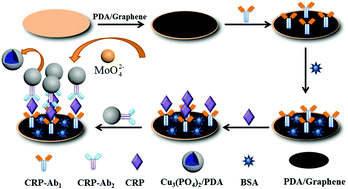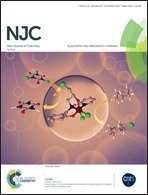Redox active molybdophosphate produced by Cu3(PO4)2 nanospheres for enhancing enzyme-free electrochemical immunoassay of C-reactive protein†
Abstract
A sandwich electrochemical immunosensor for sensitive detection of C-reactive protein (CRP) was fabricated using Cu3(PO4)2 nanospheres-induced electrochemical current. Notably, signal generation was derived from the reaction of Cu3(PO4)2 nanospheres with adscititious molybdate ions. It would form a type of redox-active molybdophosphate precipitate on the electrodes, which could facilitate the generation of a stable and direct electrochemical current. In particular, it needs to be mentioned that +0.14 V was taken as the working potential for the electrochemical immunoassay, which could reduce the possible interference of the dissolved oxygen in the electrolyte. This would be reasonably helpful for the sensitive assay of CRP. Thanks to the abundant phosphate groups in Cu3(PO4)2 nanospheres, the detection signal could be enhanced sharply. As a result, the optimized enzyme-free electrochemical immunosensor presents an ultrasensitive detection performance toward CRP with a linear range from 0.5 pg mL−1 to 1 ng mL−1 and a low detection limit of 0.13 pg mL−1. The selectivity, reproducibility and stability of the immunosensor were tested and observed to be satisfactory. In general, the proposed analytical system shows promising potential for clinical diagnosis.



 Please wait while we load your content...
Please wait while we load your content...